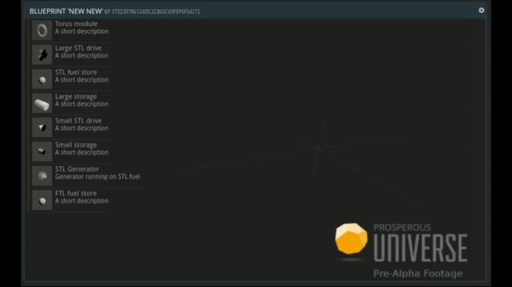On shipping
I’m interested in exploring the possibilities for how shipping and vessel construction could be implemented in game. I’ll present a few points along the design spectrum, and hopefully someone else will be interested in joining in.
Ships as preset designs
The first method, perhaps on the extreme end of simplicity, would be to implement vessels as entirely developer designed. The developers create ships with predetermined stats, such as cargo size, fuel bay size, transit velocity, etc… and these vessels are then available for construction in a Shipyard.
The main advantage of this method is the simplicity of development. Of all methods listed here, this is perhaps the easiest to develop and test.
From the user perspective, this method is very rigid. Ships may not be customized when a preset configuration does not meet your needs.
I feel this method could be a useful stopgap, however, I do not feel that it lends itself to the overall design well enough. In other aspects of the game, there is a strong push towards efficiency, and customizing your setup.
Preset hulls, with modular compartments
Building on the first method, hulls are designed by the developers and specific functionality is determined by the user/constructor. Hulls are constructed, and filled with empty compartments. The user/constructor determines which compartments fulfill which role. A cargo ship could fit more cargo compartments; a scout vessel could fit more engines; a resource harvesting ship could fit more harvesters.
Engine types could be differentiated also. A combined type engine that is useful for atmospheric and vacuum flight; A vacuum engine, which is more efficient when flying in space; an atmospheric engine which is more efficient in an atmosphere.
Vessels could be designed to long haul between space stations, never having to enter atmosphere. Shuttles could run between the surface and the station.
This method decreases the overall rigidity of the first method, but is still somewhat limiting in terms of customization options.
No preset hull sizes, entirely custom
My personal favorite method, and perhaps the most fleshed out.
Ships are constructed as a collection of components. Once constructed, ship components likely cannot be as easily changed out as in the second method.
Ship components are manufactured in a type of “Ship Component Fabricator” which could come in a variety of flavors. A general fabricator could have access to a shortened list of components, with the benefit of being available at an earlier stage of the game or where there is no specialized component fabricator.
An Engine Component Fabricator could produce strictly engine components. Other specializations could exist to allow for greater variety to be produced and allow for increased design options.
Shipyards would also be available in a variety of flavors, with each flavor determining the maximum hull tonnage / size / component count.
When setting a production order for a ship, the manufacturer would choose from a list of components with which to manufacture the ship. A simple shuttle design could be:
- 1x Sub-light engine - Tiny
- 1x Crew Compartment - Tiny
- 1x Cargo Compartment - Tiny
- 1x Sub-light Navigation Unit
- 1x Bridge - Tiny
Such a vessel would be limited to use in a single system, likely running between between a planetary surface and a space station.
Speeds are determined by the total mass of the vessel, and energy utilization of the engines. Thus a small, light shuttle would be more fuel efficient, particularly for short-haul tasks.
On the flip side, larger vessels could be designed for bulk-haul tasks, and inter-system transfers.
Ship components should be relatively generalist and not cover functionality already held by facilities. Rather, a generic component should be designed: Facility Space Component. This component would allow for construction space to be made available on a vessel. Facilities would draw their crew from the ships crew.
Using this method, ships could be designed to/for:
- Travel to a system, harvest materials, and produce prefabs/materials for permanent colony construction
- Manufacture smaller vessels
- Harvest materials from planets not yet able to be colonized
- Fast, long range exploration
- Bulk transfer of goods between systems/stations
- Fast transfer of low volume goods (emergency rations) between planets
- Act as a stop gap in colony design - manufacture needed simple materials/consumables so colonies can focus on whats really needed.
- In-transit manufacturing - Mine/pickup some ores, then smelt them on the journey home.
Conclusion
There are a large variety of methods by which shipping and vessel manufacture can be achieved. I’ve listed three, which I believe capture key points along the spectrum of design possibilities.

